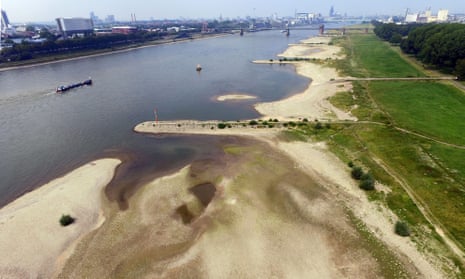A swathe of central Europe has suffered the most severe drought since 2003 in what EU climate experts see as a harbinger of climate changes to come.
Rainless weeks and relentless heat desiccated a vast tract of central European land separating the continent’s drier south from its wetter north between 1 April and 31 July, according to a report by the European drought observatory (EDO).
“This is where we expect to see more extreme weather such as floods and droughts in the future, and what we are gradually starting to see in the present,” said Frank Raes, the head of the climate change unit at the EU’s Joint Research Centre which commissioned the report.
The drought was consistent with climate models that predicted “an extreme weather battleground” between continental weather systems in central Europe, Raes said. “The big floods and droughts of the last 20 years have been in that area,” he added.
Agricultural production has now slumped in large parts of a zone stretching eastwards from central France through south-central Germany into Poland, Hungary and Ukraine, and southwards into northern Italy and Spain.
Grain harvests in Germany have fallen 11% and apple harvests 21% on last year’s figures, while a 28% drop in corn output is expected by government officials in France. In Poland, record lows in river water levels have revealed Jewish tombstones and Soviet fighter planes, as well as human remains, buried for decades or more.
At one point, the drought reached what the German environment agency called “catastrophic proportions”, with water levels on the river Elbe falling 9cm below the previous record low. At the same time, freak floods occurred in Demker, north of Magdeburg.
“Similarly to the summer of 2003, a large part of the continental EU was affected by a severe drought in June and July 2015, as a consequence of the combination of rain shortages and very high temperatures which resulted in high plant water requirement levels,” the EDO report said.
Andreas Friedrich, a spokesman for Deutscher Wetterdienst (Germany’s Met Office) agreed that the drought in Germany had been the worst for 12 years, and warned that is was not over yet. “In northern Bavaria and eastern Germany the situation is critical with an extreme drought and very high incidence of forest wildfires,” he told the Guardian. “Some parts of Germany now have the lowest levels of soil moisture since records began in 1951.”
Restrictions to civil and industrial water use have accompanied the water shortages, along with a drastic curtailing of inland water transportation and increases in both forest fires and energy consumption for cooling, according to the EDO report.
It found that monthly rainfall averages fell by as much as 80% in parts of France, and parts of northern Spain experienced daily temperatures over 30 degrees for more than 40 consecutive days.
Drought conditions did ease in August, but the European centre for medium-range weather forecasting predicts above average temperatures across the continent in September, with drier than usual conditions for most of central and northern Europe.
While the UK and some parts of Europe have been relatively unaffected by the water shortages, the drought was even worse than 2003 in regions such Limousin in France, Rhine Hessen-Phalz in Germany and Oost Vlaanderen, Belgium.
However, Dim Coumou, a climate modeller at the Potsdam Institute for Climate Impact Research advised caution in drawing conclusions about individual weather events. “It is too early to say how severe the current drought in Europe is,” he said.
“The Mediterranean is generally considered a hotspot and the models project strong increases in drought conditions there. But where exactly the [central European] belt is, I don’t think can be quantified,” he said.

Comments (…)
Sign in or create your Guardian account to join the discussion